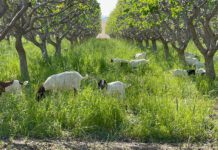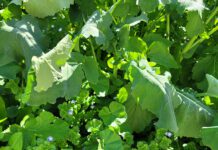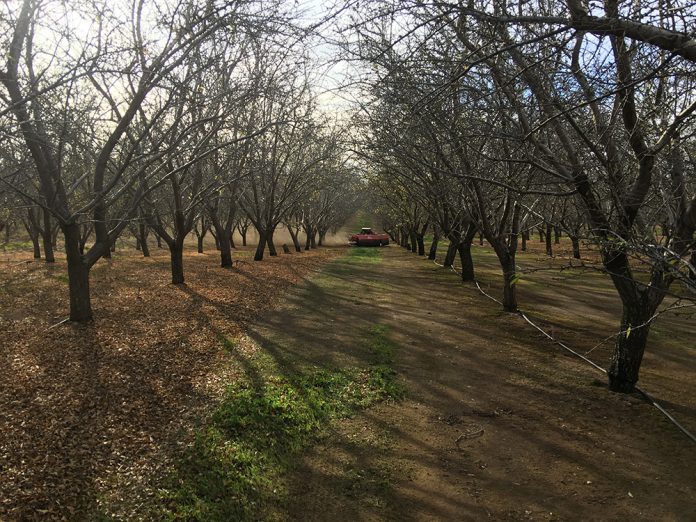
Weed control, particularly in the first few years of an orchard’s life, protects that investment in trees, the irrigation system and land preparation.
A mature orchard can shade out most large weeds, or weeds may only be a problem along orchard edges. In newly planted orchards where there may be a large weed seed bank in the soil, weed control in the tree rows prior to germination is a must. Preventing weeds from germinating is the goal with preemergence herbicides to ensure young trees receive the water, nutrients and sunlight needed for optimal growth.
Preemergence herbicides can play a large part in weed control in young orchards, but they must be applied according to label and with care to not damage tender new growth. Preemergence herbicides can help control weeds early in the growing season and may prevent the need for repeated post emergent herbicides throughout in the spring and summer. Careful application of preemergents can reduce risk of vigorous weed growth due to rain events when it is difficult to spray burndown materials.
UCCE Weed Science Farm Advisor Emeritus John Roncoroni said that paying attention to preemergence herbicide labels is an important part of a weed control program. There are restrictions for use in orchards less than three years of age. If used with a postemergence herbicide, using surfactants or activators on the label at the rates and mixing order listed is advised. For the first-year use, the herbicides Prowl, Surflan, Trellis and Goal are registered. The herbicide Alion can be used on trees established as little as one year as long as they are well established and showing normal growth. Pay close attention to the soil composition/rate chart in the label.
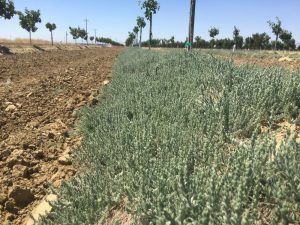
Soil Types Can Make a Difference
Roncoroni said that soil types can make a difference in efficacy of a preemergence herbicide. In heavier soils, the material may bind to the soil, and using rates at the higher end of the label may be necessary. High levels of sand in an orchard may render a preemergent ineffective as it can leach out. Lower rates may be necessary in sandy soils to prevent leaching and/or damage to young trees by absorption through the roots.
UCCE Farm Advisor Franz Niederholzer notes that uncontrolled weeds in orchards also hide vertebrate pests from predators. Although research continues into using heat and flame to control weeds, those approaches can cause damage to irrigation lines. Weed cloth may also work, but it hides gophers and voles.
Niederholzer wrote in the UCCE publication Sacramento Valley Orchard Source that applying preemergence herbicides may reduce the need for postemergence herbicide treatments during the growing season.
Correct Identification is a Must
Correct identification of weed species in their early stages of growth and knowing their resistance levels to herbicides is a factor in successful control of weeds as are correct timing of applications, use at label rates and careful spray applications.
Applying a preemergence herbicide prior to planting is an option, but the residual activity of the material may affect newly planted tree. The soil with the residual herbicide should not come in contact with newly planted trees. Many preemergence herbicides work by stopping growth of roots of seedling weeds and have limited uptake by aboveground parts of weeds and even trees, which contributes to crop safety.
Niederholzer said that intact trunk protectors are essential in first-leaf weed control. Spray hitting the trunk above the carton should be avoided. This is where smoothing out the row middles to prevent ‘boom bounce’ is a good idea. Avoiding herbicide damage to second-leaf trees is harder as most cartons have been removed or deteriorated.
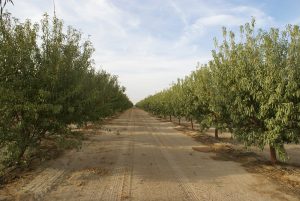
Warning on Tree Age
Many preemergence herbicide labels allow application after one year in the ground. One weed control strategy is to apply a preemergence mixed with postemergence for existing weeds in the winter or early spring while cartons remain on the trunks. After cartons are removed, allow the trunks to harden before any follow-up spray applications.
There are guidelines for preventing tree damage from herbicide applications. For second-leaf trees, trunk protection methods listed in the UC IPM guidelines noted that cartons left on trees is the best option. If they have been removed, waiting nine weeks after carton removal to spray is the second-best option. By third leaf, tougher bark on trees may allow more options for preemergence materials.
Application of preemergence herbicides in tree nut orchards may differ in timing among growing regions, but all applications need to be washed into the soil with either rain or irrigation within several weeks of the application. Roncoroni said a quarter to a half inch of water is needed to move the herbicide into the soil. Some herbicides can also be mechanically incorporated into the soil. Depending on the herbicide and its mode of action, if no water is applied or if it isn’t mechanically incorporated, the material will be gone or made less effective. Roncoroni said that if drip irrigation is used to incorporate the herbicide, only the area around the dripper that is wetted will be incorporated.
“It has been easier in the past to just get rain,” he said.
Niederholzer noted the importance of timing fall herbicide applications. In a dry fall and without irrigation, weeds can make a comeback. He suggests a sequential application for better weed control over time but noted it would take some planning.
Roncoroni added a good strategy for a sequential preemergence treatment. This is often done with pendimethalin herbicide. An early season application is made. Later in the season when irrigation is starting, summer grasses can be a problem. An application of pendimethalin can be made, often through the irrigation system before late-season grasses germinate. He said it is important that the total product applied does not exceed the yearly or seasons total allowable product specified on the label.



